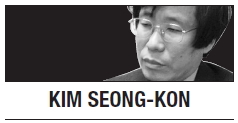Ever since the Tower of Babel, human beings have been speaking in different tongues, inevitably creating communication problems. In the course of history, some languages have become extinct, while a few have thrived and emerged as international languages widely spoken in many countries. English, for example, has clearly become an international language. In Korea, many signs are written in both Korean and English as a courtesy for foreigners.

Due to cultural and linguistic differences, however, some English signboards in Korea bear awkward English translations. One of the most common mistakes is the misuse of capitalization, which stems from the fact that there are no capital letters in the Korean language. For example, I recently ran across a curiously inconsistent menu on the wall of a government institution cafeteria. The first item on the menu was spelled: “Steamed egg.” But below, the next item was spelled “bacon,” not “Bacon.” There was no consistency in capitalization on the menu. Another item on the menu was listed as “beef (australia),” when clearly Australia should have been capitalized.
There were many other mistakes on the menu. For instance, “Fish$ chillsauce,” was probably “Fish & Chili Sauce.” Another dish was awkwardly named “vegetable (soup).” “Vegetable Soup” might have sounded more natural. Foreigners also may wonder what “Steamed egg” is. In a Western restaurant, one usually chooses from scrambled, boiled, or poached egg.
Another common mistake on the menu was the indiscriminating mixture of verbs, nouns and adjectives. For example, the cafeteria had a questionnaire that asked about the quality of the food and service. It said: “Choose one ― Very Satisfied; Satisfies; Average; Dissatisfaction; Very Dissatisfied.” In addition, a sign on the communal coffee table said: “Please return back the item to where it was after using it.” Since “back” is redundant here, the instructions should have only used the word “return” or “put back.”
When I came to the Literature Translation Institute of Korea, I was appalled to find the following announcement in the institution’s English brochure: “The LTI Korea was founded in 2001, but became a legal institution in 2004.” According to the brochure, the LTI Korea had been an “illegal” institution until 2004. To convey the right meaning, the announcement should have been translated as: “The LTI Korea officially became a state-run institution in 2004.” These sorts of mistakes occur due to the literal translation of Korean phrases into English.
The fact that the Korean language does not differentiate between singular and plural also results in the oft-incorrect usage of English. For example, in Korean one would say, “There are five apple,” instead of “There are five apples.” Thus, when Koreans translate Korean phrases into English, they often use direct translations, ignoring plural forms. That is why Koreans tend to use a singular verb after a plural subject and vice versa, when they speak or write in English. Unlike English, there is also no crystal-clear distinction between the present tense and the past tense in the Korean language. In Korea, therefore, when you happen to encounter your former high school teacher on the street and introduce him to your friend, you say, “He is my teacher.” In English, however, you would say: “He was my teacher,” or “He is my former teacher,” clearly distinguishing the past from the present.
Sometimes, confusions arise when a Westerner encounters an English name of a Korean man or woman. If the Westerner knows the Asian custom of putting one’s last name first, he may assume that Koreans do the same when they write their names in English. On the contrary, many Koreans write their names in the English fashion: first name first with the last name following. To eliminate the confusion and to preserve our cultural identity, it may be a good idea to follow the Korean fashion when it comes to writing our names in English. In fact, many Korean writers put their last name first, such as Yi Gwang-su or Yi Sang. And so do many athletes.
Nevertheless, there still may be confusion depending on the name. For example, Kim Yu-na may be mistaken as a Western woman whose name is Kimberly Yu-na. Same with Lee So-young; Lee could be a first name in English, like Lee Majors. However, if the Korean government sets up a unified format and lets the world know about it, confusion will be minimized, to be sure.
Hungarian Ambassador Miklos Lengyel recently told me that Hungarians, just like Koreans, put their last names before their first names, such as Lengyel Miklos. The Chinese people have long put their last name first when writing in English, and so do many Japanese people these days. I have two Japanese novels that were translated and published in English 30 years ago. Confusingly, one book says the author is Oe Kenjaburo (Japanese style), but the other one says Kobo Abe (English style). Today, however, Kobo Abe is referred to as Abe Kobo.
Cultural and linguistic differences often cause confusion and mistakes. Nevertheless, we can certainly deal with the differences and reach a deeper understanding despite language barriers and minor cultural misunderstandings.
By Kim Seong-kon
Kim Seong-kon is a professor of English at Seoul National University and president of the Literature Translation Institute of Korea. He can be reached at sukim@snu.ac.kr. ― Ed.








